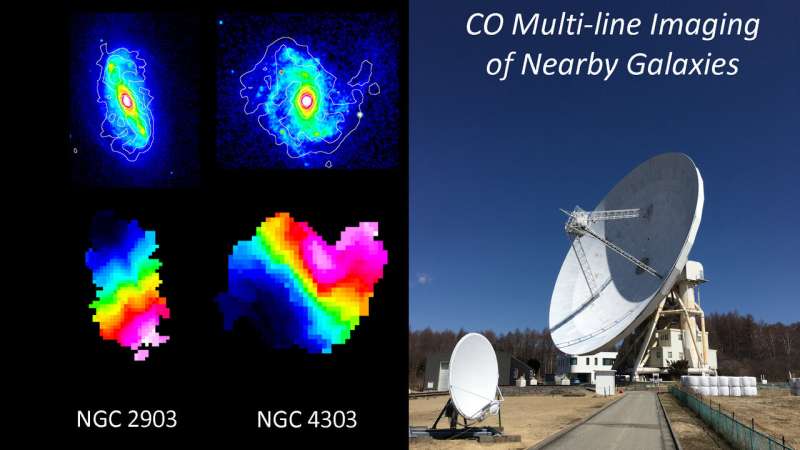New method to study barred spiral galaxies

Analysis of gas motion in 20 nearby spiral galaxies has revealed a clear difference between those with bars and those without bars. This suggests that already available data on gas motion can be used to study bars in spiral galaxies, even in the absence of high-resolution imaging data.
In spiral galaxies, a large disk of stars and gas rotates around a central bulge. Spiral galaxies take their name from bright swirls (spiral arms) in the disk where stars are more densely concentrated. Many different types of spirals have been observed, including some with straight sections known as bars.
But a galactic disk is not a solid object. Different parts of the disk rotate at different speeds, similar to the clouds in a typhoon or soap suds spinning around a drain. In fact, the motion in a galactic disk isn't limited to pure circular rotation, parts moving radially towards or away from the center can also be observed.
To better understand motion within the disk, a team led by Dragan Salak (at that time an assistant professor at Kwansei Gakuin University and now a postdoctoral researcher at the University of Tsukuba) analyzed the gas motion in the disks for a sample of 20 nearby spiral galaxies, including seven barred spirals. They found a clear difference between the kinematics of barred and non-barred galaxies. Non-barred spiral galaxies show very little radial motion at all locations. In contrast, barred spirals have on average 1.5-2 times more radial motion than non-barred spirals out to the end of the bar, but beyond the end of the bar the motion is close to circular. This result matches theoretical models where the bar structure helps to channel gas towards the center of the galaxy. The team found that the radius where the motion towards the center stops is closely related to the length of the bar, ranging between 0.8 to 1.6 times the length. This suggests that using the gas motion as a proxy for the bar could allow researchers to use modest-resolution, wide-field velocity data which are more easily available than high-resolution image data. For example, this study used the COMING survey of gas properties in nearby galaxies from the Nobeyama 45-m Radio Telescope in Japan.
Then by correlating the properties of the bar with the properties of the host galaxy, the team found that bars in more massive galaxies tend to be larger and rotate slower. This agrees with simulations where more massive galaxies provide more material for the bars to grow, but the mass of the galaxy exerts a torque which slows the rotation of the bar.
These results appeared as Salak et al. "CO Multi-line Imaging of Nearby Galaxies (COMING). VII. Fourier Decomposition of Molecular Gas Velocity Fields and Bar Pattern Speed" in December 2019 in Publications of the Astronomical Society of Japan.
More information: Dragan Salak et al. CO Multi-line Imaging of Nearby Galaxies (COMING). VII. Fourier decomposition of molecular gas velocity fields and bar pattern speed, Publications of the Astronomical Society of Japan (2019). DOI: 10.1093/pasj/psz004
Provided by National Astronomical Observatory of Japan



















